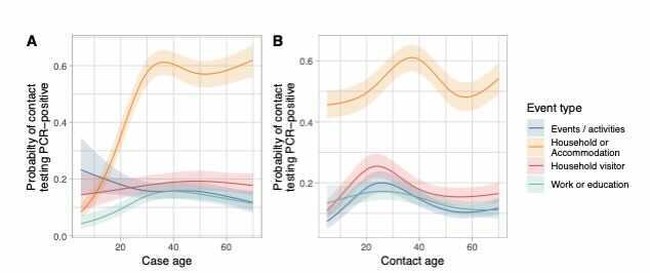A new study from the United Kingdom provides some great news about kids and COVID-19. The study looks at contacts of patients with a positive PCR test. It covers the time period when the Alpha variant was dominant through when the Delta variant became the most common. First, let’s celebrate the good news. It does not appear that the rate of children catching and transmitting COVID-19 has changed with the Delta variant.
These graphs show a lower rate of secondary infection, also called transmission, between children and adults in the precise settings where authoritarians like New York Governor Kathy Hochul are mandating masks for young children.

The green line represents work or education settings. The graph on the left shows COVID-19-positive individuals under 20 passing COVID-19 to a person at work or school at a rate of 1 in 10. Below age ten, it is 1 in 20 or less. For young children, this is a significant contrast with the overall study transmission rate. Of the 139,164 contacts of COVID-1- positive individuals studied, 51,789, or 1 in 3.8, tested positive.
This trend does not change significantly within the household. A child under the age of ten has a 1.5 in 10 chance of passing COVID-19 to a household member. That probability decreases to less than 1 in 10 at younger ages. On the right side of the graph, you see a child ten and under is more likely to test positive for COVID-19 due to a COVID-19-positive family member. Young children are far less likely to test positive than older people after contact with a COVID-19-positive individual in an educational setting. Those chances are about 1.3 in 10.
Recommended: Kids and Immunity: 15 Months Later, Banned Doctors Are Vindicated
This combination of factors supports a German study from early in the pandemic indicating that children might act as a brake on COVID-19 infections. When children contract COVID-19 outside the home, they transmit the illness to household members at a much lower rate than older people. When they catch it at home, they transmit at lower rates than the general population in educational settings. This data helps explain why several studies have shown lower rates of COVID-19 transmission in schools than in the communities around them.
These findings make the viral video of a daycare worker repeatedly masking a toddler even more infuriating. The adults in these settings have had the opportunity to get vaccinated. We should prioritize normalizing the lives of our children and their social interactions as quickly as possible. The next time Dr. Anthony Fauci refers to children as “vehicles of spread,” he should be dismissed. “Unmask the children, now!” should be a rallying cry for every parent.
When combined with what we know about the severity of illness from COVID-19 in children, this data should end any discussion of mandating vaccines for them. While much was made of a shortage of pediatric hospital beds in the Southeast during the Delta variant, almost all coverage ignored the off-season surge of respiratory syncytial virus (RSV) that occurred at the same time.
Data shows that the number of children under 18 hospitalized with or for COVID-19 during the entire pandemic has been approximately the same as the number of children under age five hospitalized annually for RSV. It is also lower than any of the last ten years for the flu. With this transmission data, anyone advocating jabbing kids is just doing it to relieve the anxiety of adults. That is the sign of a narcissistic and sick society.
Recommended: Natural Immunity for the WIN! Israeli Study Suggests COVID-19 Vaccine Policies Should Change Now
Another data point in the study looks at COVID-19 transmission rates from vaccinated and unvaccinated individuals to their contacts. Two vaccines were studied, Pfizer and AstraZeneca. Many are celebrating this finding, saying that it highlights the effectiveness of the current vaccines. This assertion is true, but readers should note that the efficacy dwindles after 12 weeks.
From the study:
Transmission reductions declined over time since second vaccination, for Delta reaching similar levels to unvaccinated individuals by 12 weeks for ChAdOx1 [AstraZeneca] and attenuating substantially for BNT162b2 (Pfizer). Protection from vaccination in contacts also declined in the 3 months after second vaccination.
Additionally:
Vaccines continue to provide protection against infection with Delta, but to a lesser degree than with Alpha, particularly considering symptomatic infections or infections with moderate/high viral loads. Therefore, Delta erodes vaccine associated protection against transmission by both making infection more common and increasing the likelihood of transmission from vaccinated individuals who become infected.
These findings confirm Israeli studies and should be at the root of the current debate about booster doses. There should be more scrutiny given to the practice of vaccinating children. It is a population that rarely suffers from severe COVID-19. The new study confirms that young children catch and transmit the virus at much lower rates than the general population. Until there is a population-level antibody seroprevalence study in the school-age population, vaccinating children should not even be on the table.










Join the conversation as a VIP Member